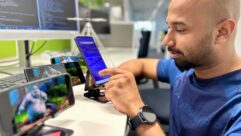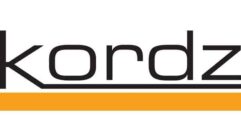
Test Marketing with AV
Oct 1, 2012 11:18 AM,
By Don Kreski
Time Warner’s Medialab

The Usability Lab is a focus group room where small groups can interact with and discuss videogames, video media, and electronic devices. There are cameras at every station capturing the user’s response.
Time Warner’s seven-month-old Medialab is one of the most sophisticated test marketing facilities ever built, employing innovative research tools to evaluate testers reactions and integrating a sophisticated audio visual system to observe, record, and analyze those reactions.
It’s a huge challenge. Today TV, movie, advertising, and video game producers have to accommodate every conceivable platform from smart phones with tiny 4in. touchscreens to home theaters producing 10ft. 3D images.
“We recognized how consumers are embracing new technologies, and we needed to better understand this rapidly growing trend,” says Martin O’Neill, Time Warner’s executive director of business and research operations. That realization lead to the development of Medialab, which opened in the Time Warner headquarters in Manhattan in February. Although media is Time Warner’s product, Medialab demonstrates the powerful ways that AV can be used for more effective product research and test marketing across a range of industries.
At the heart of this laboratory are some of the most innovative research tools ever devised – and supporting them one of the nation’s most complex and powerful audiovisual systems. Medialab has a great deal to say about product research and AV system design in a wide variety of applications.
Like other large companies, Time Warner does a great deal of testing to hone its products and its marketing of those products. Medialab can test virtually any product or any idea for the company’s nearly 100 subsidiaries, which include Warner Bros. Studios, HBO and CNN, Time and People magazines, and an interactive entertainment division that publishes the Batman and LEGO series of videogames. Medialab is open to each of these organizations plus their ad agencies and other partners for audience testing. “We might show movie trailers to a test audience or test consumer reactions to a new website,” says O’Neill. “We want to get a sense of how much they like something, what parts of it they pay attention to, and how we can improve it.”
As such, Medialab is a revenue center rather than a cost center: Time Warner charges each of their internal and external clients for the research conducted there. The AV systems, designed and integrated by San Diego-based CompView Audio Video Solutions and Support, under design engineer Jeff Kaylor and project manager/field engineer Gustavo Rosta will be amortized against that revenue. There are eight testing labs and two observation rooms in the 9,600-square-foot Medialab, each of them designed to simulate places where consumers would normally interact with media. There’s an eye-tracking lab, designed to reveal how individual test subjects view a website, movie, TV commercial, or app and how they interact with the device carrying it. There’s a mock living room for projects involving small groups of friends interacting with media and with each other. There’s a 47-seat movie theater. There’s a traditional focus group room. There’s a Usability Lab where small groups can interact with and discuss videogames, video media, and electronic devices. And there’s a mock retail area where researchers can observe how shoppers view and buy printed media, snacks, and other merchandise, and observe the effects of TV commercials seen in other rooms on viewers’ buying decisions.
In each of these spaces, thanks to an extensive closed-circuit camera system and a biometric device that measures heart rate, respiration, motion, and galvanic skin response, everything a test subject says, does and, to a large degree, feels can be observed, recorded, and analyzed.

The 47-seat theater in the Medialab building is designed to simulate an out-of-home movie-going experience. It uses a Christie Mirage HD10K-M to project 2D or 3D media on a 180in. Stewart screen. Two Samsung SCP-2120 infrared-capable PTZ cameras can record audience reactions in the dark and a Meridia Audience Response ProVote system allows them to provide feedback during or after the presentation.
Just as Time Warner faced the inherent challenges of multiple media platforms, so did CompView. The demands on the AV system are enormous. On the one hand, the system had to deliver content from virtually any consumer device currently available or to become available in the foreseeable future at full resolution. That includes content from Blu-ray, smart phones, tablets, videogame consoles, even the new 4K Blu-ray players just now being introduced. On the other hand, Time Warner needed to be able to observe, in great detail, how subjects view a web page, game, movie or video, including how their eyes track through a screen. This required a large number of pan/tilt/zoom cameras and microphones to record test subject actions, facial expressions, and comments while interacting with media. For the theater, they needed infrared-capable cameras able to record test audiences in the dark.
Inside the labs are a total of seven 22in. to 60in. 3D-capable Samsung displays, 22 Vaddio ClearVIEW HD-19 PTZ cameras, a Tobii eye-tracking camera, 11 Shure and six Polycom ceiling mics, and 27 JBL Control 25 and 26 speakers, plus nine Klipsch and five Bose loudspeakers. Media sources may include virtually any smart phone, tablet, Blu-ray Disc player, videogame console, DVR, or computer available today—and sources change constantly, depending on the research project.
“The lab was built from the ground up to be incredibly flexible,” says Steve Woodward, the Time Warner executive in charge of the technical aspects of Medialab. “It had to be because we don’t control the research or the research objectives.”
To provide this kind of flexibility, CompView installed a switching system based on five Crestron DM-MD32x32 matrix switchers and three Crestron DM-MD8x8 switchers to provide a combined 184 input by 184 output switching matrix. “It allows us to input and switch any source that we can anticipate to any destination we might ever use,” Woodward explains. CompView also used two Crestron control processors to operate the systems, with a Crestron 12in. or 15in. touchscreen in each of the labs and observation rooms and an 8” touch screen in the rack room. The system is fully compatible with the HDMI 1.4 standard, 4K video, and 3D media. iDesign Systems in Forest Hills, N.Y., did the Crestron programming.
The theater, designed to simulate an out-of-home movie-going experience, uses a Christie Mirage HD10K-M to project 2D or 3D media on a 180in. Stewart screen, with surround sound provided by a Crestron PROCISE 7.3 surround processor, a Crestron 7×400 amplifier, and nine Klipsch speakers and two subwoofers. Two Samsung SCP-2120 infrared-capable PTZ cameras can record audience reactions in the dark and a Meridia Audience Response ProVote system allows them to provide feedback during or after the presentation.
Researchers can monitor test subjects in the various labs in the observation rooms via Samsung LED monitors, one-way mirrors, and JBL Control 25 speakers. Depending on the project, test subjects may be wearing a biometric belt from Innerscope Research, which measures heart rate, respiration, motion and galvanic skin response. Data is analyzed with custom applications from Ipsos Media CT, Innerscope Research and Schlesinger Associates. These measures provides a reliable indicator for emotional engagement which can be matched moment by moment with the media.
“In addition to all these playback and capture devices, they needed a high-definition recording device capable of recording multiple video and audio streams and keeping them synchronized so that an analyst could view, at a later time, the media shown to a test subject, the subject’s actions, the subject’s facial expressions, and emotional measures and see their relationships,” explains CompView regional GM Tom Yerkes. CompView, working together with Woodward, designed the recording system based on Blackmagic Design H.264 Pro Recorders.
O’Neill says he’s excited about the capabilities the lab provides. “The Medialab is an intellectual playground that helps us bring our products to fruition and helps make them compelling for our customers.”
The quality of the AV system can be summed up in one sentence: Zero service calls to date.










